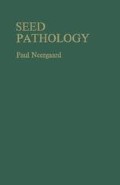Abstract
The dry seed is examined for impurities, classified partly as ‘inert matter’ in the International Rules for Seed Testing, such as plant debris, sclerotia, galls, insects, smut balls, etc., also for symptoms such as discoloration, malformation and similar indications of infection, including fruiting bodies of fungi, resting hyphae on the surface of the seed, spore or bacterial masses on the seed, as well as mechanical damage and, if required for the test, fungicidal residues. To carry out such examinations in a proper way, a low power stereoscopic microscope, with magnifications up to 50–60 times, is required, as well as good light for the observations. ‘Inert matter’ should also be incubated either on blotters or agar media, and examined after a standard period of incubation (Sections 28.1 and 28.2).
Preview
Unable to display preview. Download preview PDF.
Author information
Authors and Affiliations
Copyright information
© 1977 Paul Neergaard
About this chapter
Cite this chapter
Neergaard, P. (1977). Examination of Ungerminated Seed. In: Seed Pathology. Palgrave, London. https://doi.org/10.1007/978-1-349-02842-9_27
Download citation
DOI: https://doi.org/10.1007/978-1-349-02842-9_27
Publisher Name: Palgrave, London
Print ISBN: 978-1-349-02844-3
Online ISBN: 978-1-349-02842-9
eBook Packages: Palgrave Religion & Philosophy CollectionPhilosophy and Religion (R0)

